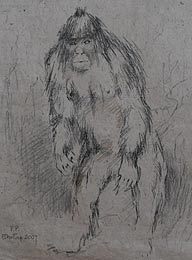Wildlife painter Polyanna Pickering was shown what is believed to be a 100-year-old yeti scalp at a remote monastery in the Himalayas.
At least one expert believe it could be the most important proof yet that the giant apelike beast is more than mere folklore.
Ms Pickering was gathering material for a new exhibition in the remote Bhutan region of the Himalayas when she made her chance discovery - with a little help from David Beckham.

|
| ©Martin Charlesworth |
| The sketch was produced with the help of eyewitness accounts |
She said: "I was told this was from a Migoi - their name for the yeti. All I know is, it was bigger than any human or ape scalp I have ever seen.
"It had tufts of reddish-black fur coming out of it and was mounted on a pole and seen as a holy relic."
The scalp was housed in a part of the monastery closed to visitors.
"The sole occupant was a caretaker monk who got very excited when he found out we were English and he was a huge David Beckham fan and then ushered us through to the back."
Photography is banned in all such monasteries but Ms Pickering, 65, was able to make a rough sketch of the scalp.
She also produced a full sketch of the creature, based on scores of eyewitness accounts by indigenous people.
"I was amazed when they told me of regular sightings, close encounters and even tales of people being carried off by the Migoi," she said.
"Their descriptions were so detailed, I ended up doing this 'photo-fit' with them all sitting round telling me to alter this or how that should look."
Jonathan Downes, director of the Centre of Fortean Zoology, which studies mystery animals, said: "If this is true it is the most important zoological discovery in 70 years."
He added: "This is potentially explosive. If this scalp is authentic and has bone still attached, it will probably be the single most important zoological find since the discovery of the coelacanth."
Mr Downes said the discovery was unique because the scalp still had a portion of bone attached to it.
He said: "Other yeti scalps have been found before but this is the only one with bone attached. The others turned out to be man-made.
"Quite a lot of the Buddhist monks dress up as Yetis as part of their religious ceremonies and explorers mistook religious costume as Yeti scalps."
Experts believe if it does exist the Yeti is a likely descendant of a giant ape which lived in India and China about half a million years ago.
Ms Pickering's sketches form part of her new Land of the Thunder Dragon exhibition, the name the Bhutanese people give to their region.
She is transforming her gallery in the Derbyshire village of Oaker into a Himalayan temple for the opening of the exhibition, which opens on Saturday June 14.



Reader Comments
to our Newsletter